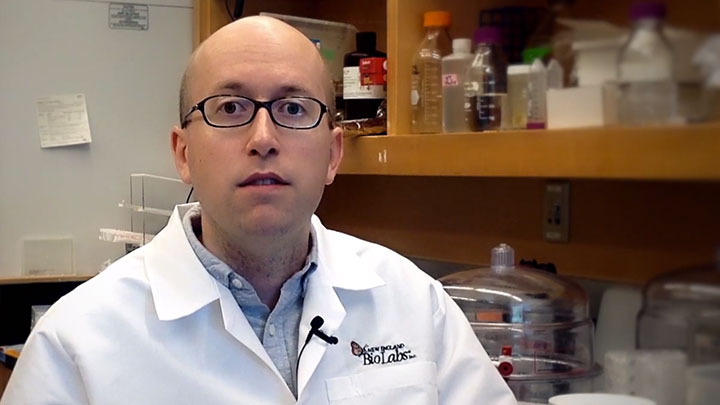Behind the Paper with Greg Lohman
Script
Greg Lohman:
So you can use this ligation to probe mRNAs, microRNAs, or any other RNA structure by designing two DNA probes that are complementary to your target mRNA. If they anneal onto the RNA and you ligate them together, now you can use any sort of DNA amplification or detection methodology to detect that DNA strand. Which is generally a lot more robust than detecting the RNA directly. So you can for example use qPCR, quantify the DNA, or you could do a whole bunch of these probes in one reaction and profile them via sequencing through a method called RASL-Seq.
So what you want then is a ligase that is very active for these hybrid helices, won't ligate the DNA probes as long as they're not annealed to the RNA, and that becomes sensitive to small nuclear polymorphisms in the RNA target, so you can interrogate one or two-base differences between a range of targets. Different microRNAs for example.
We started a screen then of ligases to try and find something that does this DNA ligation once you apply an RNA much more efficiently than T4 DNA Ligase and ideally something that does it with a much tighter binding constant than T4 DNA Ligase. So that you can be confident of being able to probe for very low concentrations of naturally-occurring RNA.
So, when we started screening, much to our surprise, we found that Chlorella Virus Ligase, which is actually one of the best characterized ligases out there, can do this reaction with a very high degree of efficiency. It is still definitely a DNA ligase. It's preferred substrate is fully DNA. But it was able to ligate these DNA splinted by RNAs between 20 and 200 fold faster than T4 DNA Ligase at it's maximum turnover and had a binding constant about two or three hundred times tighter than T4 DNA Ligase.
What this translated to as one of our early reactions, you could ligate one of these substrates to completion in about 20 minutes, nearly 95 plus percent yield. Under the same conditions, T4 DNA Ligase would get about 50 percent in about five days. So we were surprised but this was a really big improvement, so we're really excited about this.
So the nucleic acids research paper really goes into details of this activity. We find that it's very general. It'll take many sequences. It'll do all these sequences to a high degree of completion. As I said it's very tight binding, it's faster turnover than T4 DNA Ligase, and it works under a wide range of buffer conditions. It's not that sensitive to pH, it's not at all sensitive to ATP, which high ATP concentrations just wipe out T4 DNA Ligase on this particular substrate.
We really think that Chlorella Virus Ligase is gonna become the enzyme of choice for doing these ligations of DNA probes on RNA targets, and hopefully will allow for a great improvement in all these sort of RNA detection methodologies.
In addition to the research paper, we were also able to make a formulation of the enzyme optimized for research, which we are now selling under the name SplintR Ligase.
So if you would like the full experimental details the paper is available for free online, and if you have any other questions feel free to call us.
Related Videos
-

Behind the Paper: Visual Detection of Isothermal Nucleic Acid Amplification Using pH-sensitive Dyes -

Behind the Paper: Using the Human Methyl-Binding Domain to Partition Genomic DNA Derived from Plant Tissues -

Behind the Paper: An engineered Fbs1 carbohydrate binding protein for selective capture of N-glycans and N-glycopeptides

